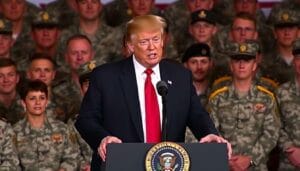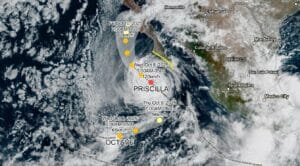Russian Nuclear Targets in the USA: What You Need to Know
Explore the critical facts about Russian nuclear targets in the USA, analyzing potential risks and strategies for national safety.

Russian Nuclear Targets in the USA
Click to summarize this article.
Russian Nuclear Targets in the USA: The idea of a nuclear attack on the United States worries many. Knowing the likely targets is crucial for ensuring safety and creating effective laws. This piece examines Russian targets in the United States, with a focus on cities, military bases, and key buildings.
Big cities like Washington, D.C., New York, and Los Angeles are likely to be among the first to be affected. They are essential for politics, money, and culture. However, some places might be chosen to demonstrate strength without harming too many people. We’ll examine why these spots are selected, including their value, population density, and economic impact.
Russian Nuclear Targets in the USA: What You Need to Know Key Takeaways
- The strategic importance of potential nuclear targets in the United States encompasses political, economic, and military factors.
- Urban centers like Washington, D.C., and New York are primary targets due to their significance.
- Remote locations may be targeted initially to reduce civilian casualties.
- A thorough nuclear threat assessment is crucial for preparation.
- Knowing where attacks might occur helps in creating effective defense plans.
Introduction to Russian Nuclear Strategy
To understand Russian nuclear strategy, it is essential to comprehend its fundamental components and their evolution. Nuclear weapons have changed how countries defend themselves. They employ deterrence and careful planning to maintain peace.
Overview of Nuclear Warfare
Nuclear warfare uses nuclear bombs to hurt enemies. It causes enormous damage and many deaths. The US has developed strategies to fight back and protect itself.
Places like big cities and military bases are key in planning. Knowing where to aim is crucial. You can read more about this at this link.
Importance of Deterrence
Deterrence is significant in nuclear strategy. It means being able to hurt so much that no one will attack. This idea has transformed how countries communicate with each other.
The balance of power between countries like the US and Russia is essential. It keeps everyone from starting a nuclear war.
Historical Context
The Cold War was a time of great rivalry and fear of nuclear war. Both the US and the Soviet Union built up big atomic arsenals. This led to considerable tension.
Today, the US uses what it learned from the Cold War to defend itself. This helps us understand how they deal with nuclear threats now.
Today’s world is full of old and new challenges. As tensions change, so must our approach to defending against nuclear threats. This helps keep everyone safe and the world stable.
Key Russian Nuclear Capabilities
Russia has many nuclear weapons and ways to deliver them. Understanding these helps us comprehend their impact on global security.
Types of Nuclear Weapons
Russia has many kinds of nuclear weapons. Some are designed for battles, while others are suited for long-distance attacks. These weapons make other countries worry about their safety.
Delivery Systems and Platforms
Russia uses many ways to send its nuclear weapons. They possess missiles on land, at sea, and in the air. These include missiles on submarines and bombers. This makes it hard for others to defend against them.
Short-Range vs. Long-Range Threats
There are significant differences between short-range and long-range nuclear weapons. Short-range ones can start fights close by. Long-range ones can hit targets quickly from a great distance. This is a significant concern for countries worldwide.
These abilities demonstrate the importance of maintaining global safety. For more info on nuclear threats, check out this link.
Top Target Areas in the USA
In a nuclear strike, knowing where to target in the United States is crucial. These spots are chosen for their historical significance, notable individuals, and key landmarks. We’ll examine the primary targets, such as cities, military bases, and locations for communication and information sharing.
Urban Centers and Major Cities
Cities like New York, Los Angeles, and Chicago are big targets. They have a large number of people and are essential for financial gain, culture, and communication. Enemies might choose these places to cause big damage and loss of life.
Military Installations
The U.S. has many military bases that are top targets. Places like Fort Bragg, Norfolk Naval Base, and Peterson Air Force Base are key. If hit, they could hurt the U.S. military’s ability to fight back.
Infrastructure and Communication Hubs
The U.S. power grid, big bridges, and roads are essential. So are places for talking and sharing info, like the internet and satellites. If these are hit, it would cause a lot of trouble right away and for a long time.
| Category | Examples |
|---|---|
| Urban Centers and Major Cities | New York City, Los Angeles, Chicago |
| Military Installations | Fort Bragg, Norfolk Naval Base, Peterson AFB |
| Infrastructure and Communication Hubs | National power grid, major bridges, and internet backbones |
Factors Influencing Target Selection
Choosing nuclear targets is a careful decision. Many factors, like geopolitical tensions and nuclear defense, shape it. Knowing these helps us see why nuclear powers make confident choices.
Strategic Importance
Essential targets are picked first. They are key to a country’s defense. Military bases, control centers, and missile silos are often chosen. This is because hitting them weakens an enemy’s ability to fight back.
This shows how nuclear defense helps prevent war by making both sides afraid of losing everything.
Population Density
Places with large populations, such as big cities, are often targeted. A nuclear blast in a crowded area can cause enormous damage. It can burn people up to 13 kilometers away.
This illustrates the devastating consequences of a nuclear war in densely populated areas.
Economic Impact
Places that are important for a country’s economy are also targets. Hitting financial areas, roads, and factories can hurt a country’s economy. A strike in New York could kill over a million and stop the world’s economy.

Examining these factors helps us understand why targets are selected. It’s essential to continue studying to develop more effective defense plans against nuclear threats.
Recent Developments in Russian Missile Technology
Recently, significant advances have been made in military technology. This is true for Russian missiles. These changes are crucial for Russia and global security.
Advances in Hypersonic Weapons
Hypersonic weapons go faster than Mach 5. They are key parts of Russia’s military updates. The Kinzhal and Avangard show these speeds.
They are very hard to stop. This makes them a significant threat to current defenses.
Development of New Intercontinental Ballistic Missiles
Russia is also working on new missiles. The “Oreshnik” is one example. It can hit targets over 5,500 kilometers away.

Cyber Capabilities
Russia is also improving its capabilities in cyber warfare. They are working hard to enhance their cyber skills. They might use these skills to attack essential systems.
Reports indicate that they plan to use cyber capabilities with missiles. This could make their attacks even stronger. According to The Bulletin, Russia’s cyber skills could pose a significant threat to the world.
Russia’s new missile and cyber technologies show that it is getting stronger. This makes the world’s safety even more challenging.
International Relations and Nuclear Posturing
Global security is constantly changing. International relations and nuclear posturing are key in this change. They shape how countries deal with each other.
Geopolitical tensions affect how countries plan their defense strategies against the US. It’s essential to have balanced discussions, such as those about nuclear threat assessment between the US and Russia.

Impact on US-Russia Relations
The US and Russia have had ups and downs in their relationship. Recently, their nuclear posturing has heightened tensions. This has made them rethink their defense strategies.
They have tried to make treaties to reduce nuclear threats. But, these efforts have had ups and downs. This is due to politics and new military technology.
Role of NATO
NATO’s actions in Eastern Europe have affected US-Russia relations. NATO’s defense plan has prompted both sides to reassess nuclear threat assessments and US defense strategies. NATO’s presence is perceived as a threat by Russia, further complicating matters.
Diplomatic Efforts
Diplomacy is key to reducing nuclear threats. Summits and talks aim to close the gaps caused by geopolitical tensions. The discussions about arms control treaties demonstrate the effort to strike a balance in nuclear threat assessment. This is all aimed at maintaining global stability.
| Key Aspect | US-Russia Relations | Role of NATO | Diplomatic Efforts |
|---|---|---|---|
| Focus | Bilateral treaties and negotiations | Collective defense and deterrence | Arms control and diplomatic dialogues |
| Challenges | Political fluctuations, military advancements | Perception of threat, military exercises | Lack of trust, differing priorities |
| Outcome | Increased geopolitical tensions | Revamped US defense strategies | Enhanced nuclear threat assessment |
Public Perception of Nuclear Threats
How people perceive nuclear threats influences their opinions and decisions. In the U.S., views on nuclear war differ by age, education, and media. Knowing these factors helps understand public feelings and create better awareness plans.
American Sentiment Towards Nuclear Warfare
Americans’ thoughts on nuclear war started with the Cold War. But views have changed over time. The fear of atomic war is intense, but awareness and readiness vary.
Recently, worries about nuclear threats have grown. This is due to Russia’s nuclear moves. It shows we need a public that knows and can act on threats.
Media Coverage and Misinformation
The media shapes how we see nuclear threats. Stories about Russia’s atomic actions can raise awareness or spread wrong information. It’s key to have accurate and careful reporting.
Good reporting helps people understand, not just fear. If not handled correctly, the media can make people more anxious and misinformed.
Nuclear Awareness Initiatives
Many efforts aim to teach people about nuclear threats. These include school programs, community work, and social media. The goal is to inform people about potential threats and provide guidance on how to respond effectively.
By informing people, these plans hope to reduce panic. They want to help people stay strong in the event of a nuclear incident.
Preparing for Possible Threats
As global tensions rise, governments worldwide are working on plans for nuclear threats. It’s key to have a strong government response to nuclear threats. This includes plans at all levels to ensure the safety of people.
Government Preparedness Plans
Governments are making detailed plans for different scenarios. These plans address immediate needs, such as evacuation routes and emergency supplies. For example, Sweden has given out millions of pamphlets on crisis preparedness.
Civil Defense Measures
Civil defense is crucial for protecting the public from nuclear threats. Countries like Sweden have guides for crises. They also focus on building shelters and conducting drills.
Public Education Campaigns
Public education is key to keeping citizens informed. Campaigns educate people about risks and safety. Countries like Finland and Norway are implementing various initiatives to educate their citizens. For more on global efforts, read here.
In summary, a strong government response to nuclear threats is essential. So are civil defense and public education. As nations improve their readiness, individual awareness is also necessary.
What Can Citizens Do?
Citizens play a crucial role in enhancing civil defense and supporting security plans against nuclear threats. Being ready and taking action can help.
Understanding Emergency Protocols
Everyone needs to know and follow emergency plans. Government agencies give clear steps for before, during, and after a nuclear event. Make sure to learn about evacuation paths, where to find shelters, and how to stay in touch.
Engaging in Political Discussions
Participating in local discussions is crucial for shaping defense policies. Attend community meetings, speak with local leaders, and participate in security discussions. This helps make our society more ready for emergencies.
Supporting Peace Initiatives
Helping peace efforts is another way to lower nuclear threat risks. Join or support groups that work towards peace and diplomacy. Also, push for peaceful solutions in politics. This makes the world safer for everyone.
| Action | Impact |
|---|---|
| Understanding Emergency Protocols | Enhances personal and community safety during crises. |
| Engaging in Political Discussions | Influences policies and strengthens civil defense initiatives. |
| Supporting Peace Initiatives | Reduces the risk of nuclear conflict through advocacy and support. |
The Role of Nuclear Nonproliferation
Nuclear nonproliferation is crucial to maintaining global safety and stability. It stops atomic weapons from spreading. This helps avoid big security problems.
Treaties and agreements are the primary tools for this. They help stop nuclear weapons from getting worse.
Importance of Treaties and Agreements
The Treaty on the Non-Proliferation of Nuclear Weapons (NPT) is of great importance. It helps prevent the spread of nuclear weapons. It also enables us to harness atomic energy for beneficial purposes.
These treaties demonstrate the collective effort of everyone working together to maintain global safety.
Recent Nonproliferation Efforts
Recently, there has been considerable effort to halt the development of nuclear weapons. Countries are talking a lot to make things better. For example, the United States is helping get more countries to agree to the CTBT.
This work is crucial in keeping the world safe from nuclear threats.
Global Cooperation vs. National Interests
Finding a balance between working together and looking out for oneself is a challenging task. Collaborating is crucial for preventing the spread of nuclear weapons. But countries also look out for their safety and interests.
Diplomacy and talking together are key to finding a way to work together. The CIA Director’s warning about nuclear weapons shows how urgent this is.
Ethical Considerations of Nuclear Warfare
War with nuclear weapons is a big worry today. It could hurt many people and cause huge damage. We need to think hard about who uses these weapons and why.
Humanitarian Impact of Nuclear Strikes
Nuclear attacks hurt civilians a lot. They cause many deaths and sicknesses from radiation. They also destroy buildings and homes.
The damage is so bad that we must question if it’s ever right to use these weapons.
Using weapons that can cause such widespread destruction is deeply wrong. The damage also affects the environment far beyond its immediate vicinity.
Moral Responsibility of Nuclear Powers
Nations with nuclear weapons must stop wars from getting worse. They should try to solve problems peacefully. They should also work together to control the use of firearms.
By doing this, they demonstrate their commitment to keeping the world safe. They help everyone work together for peace.
Conclusion and Future Outlook
Nuclear war is a big worry in world relations. New missile technology and shifting nuclear plans increase risks. But, there are efforts to lessen these dangers.
It’s key to understand these risks and work towards peace. This is crucial for maintaining global safety.
Ongoing Risks
New nuclear tools, like hypersonic weapons, show ongoing threats. New tech could make atomic war easier. This makes diplomacy and managing risks very important.
We must remain vigilant and have robust defense plans. This is how we face new threats.
Strategies for Enhanced Security
Peace and security need diplomacy, treaties, and better defense. Governments should focus on disarmament talks and global teamwork. This helps stop more countries from getting nuclear weapons.
Strong alliances, such as NATO, and open communication help maintain stability. They prevent things from getting worse.
The Path Toward Global Stability
Stability requires a combination of diplomatic, military, and civil actions. Teaching people about nuclear threats helps communities get ready. It makes them stronger.
Supporting nonproliferation, being open, and backing global agreements are key. These steps help us move towards a safer, more peaceful world.
Russian Nuclear Targets in the USA FAQ
What are some possible Russian nuclear targets in the USA?
Big cities like New York and Los Angeles are targets. So are key military bases and essential spots for communication and logistics.
What is the importance of nuclear deterrence?
Nuclear deterrence stops nuclear attacks. It ensures that any attack will lead to a significant retaliation. This keeps the peace.
How has nuclear strategy evolved from the Cold War to today?
Nuclear strategy has changed a lot. Now, it focuses on precise strikes and advanced technology. This includes missiles and cyberattacks.
What types of nuclear weapons does Russia possess?
Russia has many nuclear weapons. They have short-range and long-range missiles. They also have submarines and bombers to deliver these.
What are the recent advancements in Russian missile technology?
Russia has made significant advances in missile technology. They have hypersonic weapons and new missiles. They also have better cyber tools to mess with US defenses.
How does population density influence nuclear target selection?
Places with lots of people are often chosen. This is to cause significant damage and scare others. It aims to disrupt society and spread fear.
What is NATO’s role in nuclear posturing?
NATO plays a key role in stopping nuclear threats. They work together to ensure everyone’s safety. This stops enemies from using nuclear weapons.
How does the American public perceive the threat of nuclear war?
People in the US have different views. This depends on what they see in the news, their history lessons, and what they hear. It leads to a mix of fear, awareness, and doubt.
What measures are in place for government preparedness against nuclear threats?
The government has plans in place for addressing nuclear threats. They have local and federal plans, a civil defense system, and educate the public. This gets everyone ready for emergencies.
How can citizens prepare for a nuclear emergency?
People can learn about emergency plans. They can discuss policies and promote peace. This helps lower the chance of nuclear war.
What is the role of nuclear nonproliferation treaties?
These treaties stop more countries from getting nuclear weapons. They help disarm and work together. This keeps the world stable and safe.
What are the ethical considerations of nuclear warfare?
Nuclear war is terrible. It hurts people and the environment for a long time. It’s a big moral issue for countries with these weapons.





